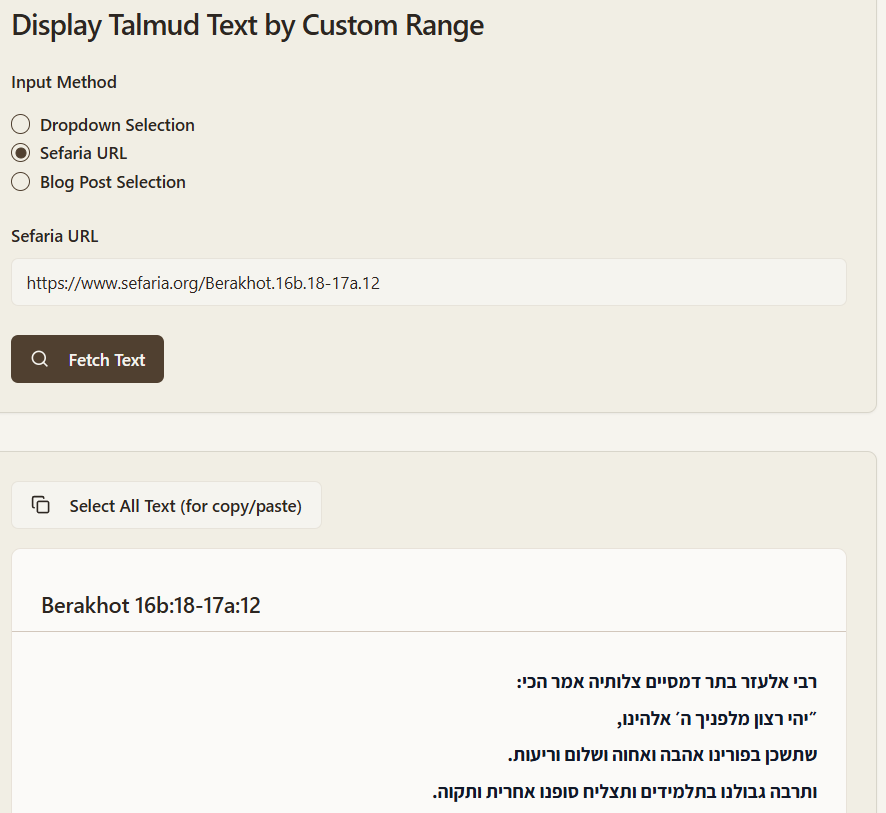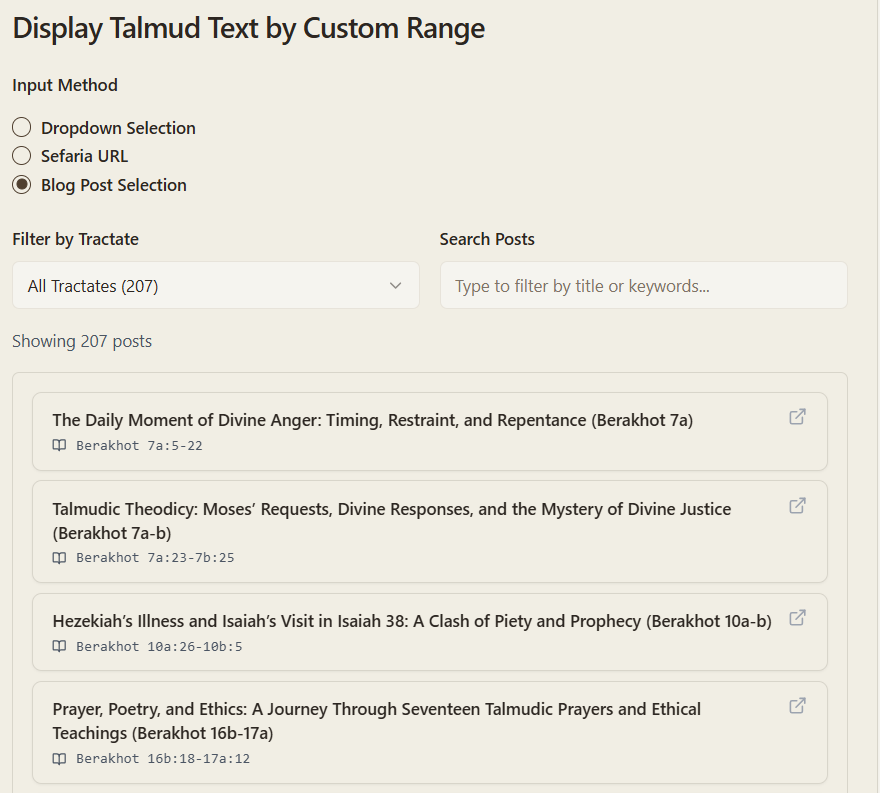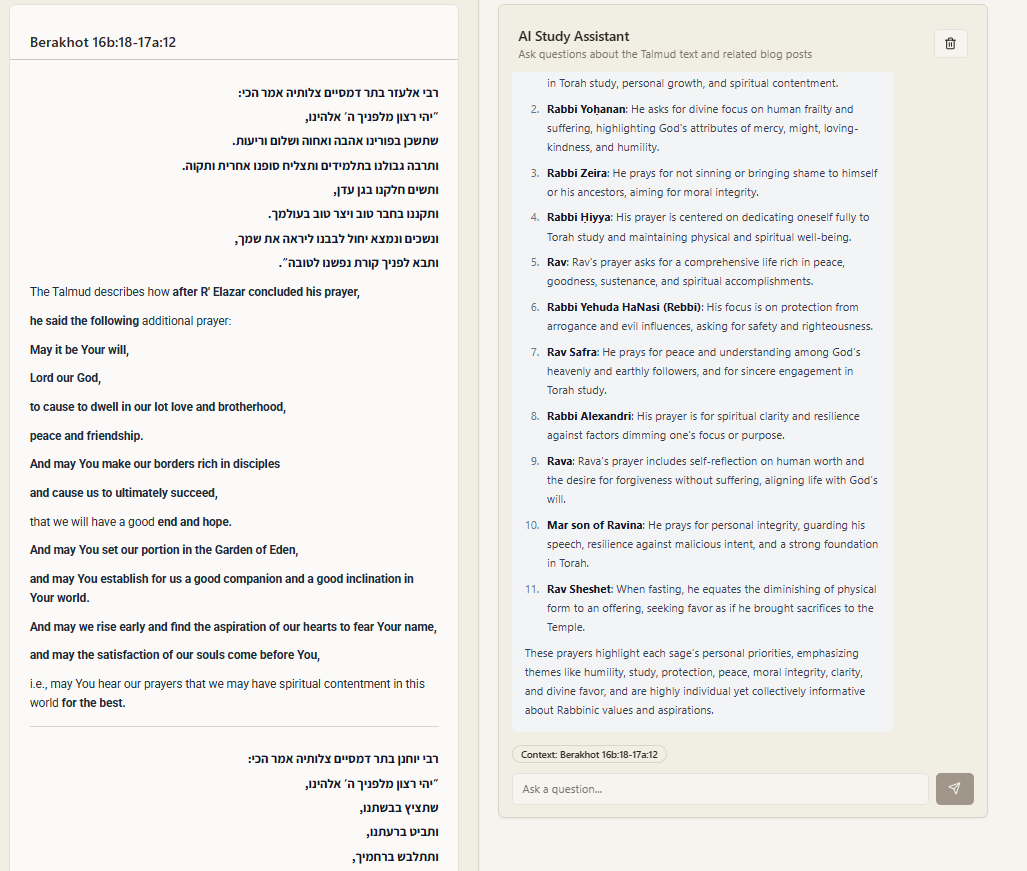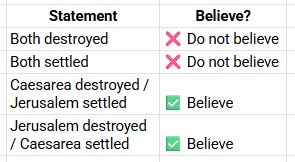Pt2 Mapping Roman-Era Eretz Yisrael: From Biblical Place-Names to the Powers of Edom (Megillah 6a-b)
This is the second and final part of a two-part series. Part 1 is here; the outline of the series can be found at Part 1.1
R’ Abbahu - Biblical “Ekron” = contemporary Caesarea, “daughter of Edom,” sitting in the sands and functioning as a “spike” against Israel in Greek and Hasmonean times; later called “Aḥidat Migdal Shir” after Hasmonean victory - Zephaniah 2:4
אמר רבי אבהו:
״ועקרון תעקר״ —
זו קסרי בת אדום,
שהיא יושבת בין החולות,
והיא היתה יתד תקועה לישראל בימי יוונים.
וכשגברה מלכות בית חשמונאי ונצחום --
היו קורין אותה ״אחידת מגדל שיר״.
§ The Talmud continues its discussion with regard to identifying places mentioned in the Bible.
R’ Abbahu said:
“And Ekron shall be uprooted” (Zephaniah 2:4).
This is an allusion to Caesarea, daughter of Edom2
which is situated among the sands.
And it was a spike stuck in the side of the Jewish people already in the days of the Greeks, as it was an obstacle to the spread of Jewish settlement.
When the Hasmonean monarchy prevailed and triumphed over them,
they called it: “The captured tower of Shir (אחידת מגדל שיר)”
R’ Yosei b. Ḥanina - Interprets verse allegorically as referring to Greco-Roman pagan temples and stone-pile cult sites; synagogues and study halls in Rome; theaters and circuses that will (in the messianic future) become venues for teaching Torah - Zechariah 9:7
אמר רבי יוסי בר חנינא,
מאי דכתיב:
״והסירותי דמיו מפיו
ושקוציו מבין שיניו
ונשאר גם הוא לאלהינו״.
R’ Yosei bar Ḥanina said:
What is the meaning of that which is written:
“And I will take away his blood out of his mouth,
and his detestable things from between his teeth,
and he also shall be a remnant for our God; and he shall be as a chief in Judah, and Ekron as a Jebusite” (Zechariah 9:7)?
״והסירותי דמיו מפיו״ —
זה בית במיא שלהן.
״ושקוציו מבין שיניו״ —
זה בית גליא שלהן.
״ונשאר גם הוא לאלהינו״ —
אלו בתי כנסיות ובתי מדרשות שבאדום.
״והיה כאלוף ביהודה ועקרון כיבוסי״ —
אלו תראטריות וקרקסיות שבאדום,
שעתידין שרי יהודה ללמד בהן תורה ברבים.
The verse should be understood as follows:
“And I will take away his blood out of his mouth”;
this is referring to their house of altars,3 where they sacrifice offerings.
“And his detestable things from between his teeth”;
this is referring to their house of piles (בית גליא), where they heap their ritual stones.
“And he also shall be a remnant for our God,”
these words are referring to the synagogues and study halls in Edom (=Rome).
“And he shall be as a chief [aluf ] in Judah, and Ekron as a Jebusite,”
these words are referring to the theaters [tere’atrayot] and the circuses [kirkesayot] in Edom
where the officers (שרי) of Judah (i.e. Jewish leaders) are destined to teach Torah in public.
R’ Yitzḥak - Biblical “Leshem” = contemporary “Pamyas”
אמר רבי יצחק:
לשם --
זו פמייס,
R’ Yitzḥak said:
“And the children of Dan went up and fought against Leshem” (Joshua 19:47);
this is referring to the city that was known in the Talmudic period as Pamyas.
Biblical “Ekron” = contemporary Caesarea; biblical “daughter of Edom,” is the contemporary royal metropolis where kings are numerous / appointed - Zephaniah 2:4 - Joshua 19:47
״עקרון תעקר״ —
זו קסרי בת אדום,
שהיא היתה מטרופולין של מלכים.
איכא דאמרי:
דמרבי בה מלכי,
ואיכא דאמרי:
דמוקמי מינה מלכי.
“Ekron shall be uprooted” (Zephaniah 2:4);
this is referring to Roman Caesarea (“the daughter of Edom”),
which was a metropolis,4 i.e., a capital city, of kings.
There are those who say
this means that kings were raised there,
and there are those who say
it means that kings were appointed from there, meaning the kings of Edom were appointed from among the residents of this city.
The fraught geopolitical and metaphysical Relationships between Rome/Edom, Italy, Caesarea, Germania, and Jerusalem
Caesarea (representing Edom/Rome) and Jerusalem (representing the Jews) are in inverse relation: they cannot both be destroyed or settled; when one is “full,” the other is “laid waste,” based on a verse about Tyre rejoicing over Jerusalem’s fall - Ezekiel 26:2
קסרי וירושלים,
אם יאמר לך אדם: חרבו שתיהן —
אל תאמן.
ישבו שתיהן —
אל תאמן.
The rabbis said that the fortunes of Caesarea, which represents Rome, and Jerusalem are diametric opposites.
If, therefore, someone says to you that both cities are destroyed --
do not believe him.
Similarly, if he says to you that they are both settled in tranquility --
do not believe him.
חרבה קסרי
וישבה ירושלים,
חרבה ירושלים
וישבה קסרי —
תאמן
If, however, he says to you that
Caesarea is destroyed
and Jerusalem is settled,
or that
Jerusalem is destroyed
and Caesarea is settled --
believe him.
שנאמר: ״אמלאה החרבה״.
אם מליאה זו —
חרבה זו,
אם מליאה זו —
חרבה זו.
As it is stated: “Because Tyre has said against Jerusalem: Aha, the gates of the people have been broken; she is turned to me; I shall be filled with her that is laid waste” (Ezekiel 26:2), and Tyre, like Caesarea, represents Rome.
Consequently, the verse indicates that
if this city is filled --
that one is laid waste,
and if that city is filled --
this one is laid waste.
The two cities cannot coexist.
Rav Naḥman bar Yitzḥak - Supports the same inverse-relationship idea from the oracle about Jacob and Esau (one people’s strength necessarily entails the other’s weakness) - Genesis 25:23
רב נחמן בר יצחק אמר
מהכא:
״ולאום מלאום יאמץ״.
Rav Naḥman bar Yitzḥak said:
The same idea may be derived from here, a verse dealing with Jacob and Esau:
“And the one people shall be stronger than the other people” (Genesis 25:23),
teaching that when one nation rises, the other necessarily falls.
R’ Yitzḥak - Interprets verse as a dialogue between Isaac and God about Esau: Isaac requests favor for Esau; God responds that he is wicked and will act corruptly even in a land of uprightness and will destroy Eretz Yisrael; Isaac concludes that such a figure will not behold God’s majesty - Isaiah 26:10
ואמר רבי יצחק,
מאי דכתיב:
״יוחן רשע
בל למד צדק״.
§ Having mentioned Edom, the Talmud cites what R’ Yitzḥak said:
What is the meaning of that which is written:
“Let favor be shown to the wicked,
yet will he not learn righteousness; in the land of uprightness he will deal wrongfully, and will not behold the majesty of YHWH” (Isaiah 26:10)?
אמר יצחק לפני הקדוש ברוך הוא:
רבונו של עולם!
יוחן עשו.
אמר לו: רשע הוא!
אמר לו: ״בל למד צדק״.
אמר לו: ״בארץ נכוחות יעול״.
אמר לו: אם כן, ״בל יראה גאות ה׳״.
Isaac said before God:
God!
let favor be shown to Esau, my beloved son.
God said to him: Esau is wicked.
Isaac said to God: “Yet will he not learn righteousness,” i.e., is there no one who can find merit in him?
God said to him: “In the land of uprightness he will deal wrongfully,” meaning that he is destined to destroy Eretz Yisrael.
Isaac said to God: If it is so that he is that wicked, “he will not behold the majesty of YHWH.”
R’ Yitzḥak - Reads verse as Jacob asking God not to grant Esau’s desires and not to remove the “muzzle” restraining him; identifies this “zemam” with the threat of Germamya of Edom (=Germany), which, if unleashed, would destroy the world - Psalms 140:9
ואמר רבי יצחק,
מאי דכתיב:
״אל תתן ה׳ מאויי רשע
זממו אל תפק
ירומו
סלה״
And R’ Yitzḥak also said:
What is the meaning of that which is written:
“Grant not, O YHWH, the desires of the wicked;
further (תפק) not his evil device (זממו),
so that they not exalt themselves.
Selah” (Psalms 140:9)?
אמר יעקב לפני הקדוש ברוך הוא:
רבונו של עולם!
אל תתן לעשו הרשע תאות לבו.
״זממו אל תפק״ —
זו גרממיא של אדום,
שאלמלי הן יוצאין --
מחריבין כל העולם כולו.
Jacob said before God:
God!
grant not to the wicked Esau the desires (תאות) of his heart, as he wishes to destroy us.
Further not his evil device [zemamo]; do not remove the muzzle [zamam] that constrains him and prevents him from breaking out and gathering further strength.
This is a reference to Germamya of Edom, i.e., Germany, which is near the land of Edom, i.e., Rome.
As, if the Germans would go forth --
they would destroy the entire world.
R’ Ḥama b. Ḥanina - Expands on Germamya and Rome: describes 300 crown-princes in Germamya and 365 chieftains in Rome, engaged in constant low-level war that continually kills a leader and forces replacement (thereby occupying Rome and preventing overwhelming power)
ואמר רבי חמא בר חנינא:
תלת מאה קטירי תגא איכא בגרממיא של אדום,
ותלת מאה ושיתין וחמשה מרזבני איכא ברומי,
ובכל יומא נפקי הני לאפי הני
ומקטיל חד מינייהו,
ומיטרדי לאוקמי מלכא.
And R’ Ḥama b. Ḥanina said:
There are 300 young princes with crowns tied (קטירי תגא) to their heads in Germamya of Edom,
and there are 365 chieftains [מרזבני - marzavnei] in Rome.
Every day these go out to battle against those,
and one of them is killed,
and they are preoccupied with appointing a new king in his place.
Since neither side is united, neither side is able to achieve a decisive victory. It is these wars between Rome and the Germanic tribes that act as a muzzle upon Esau-Edom-Rome and prevent it from becoming too strong.
R’ Yitzḥak - “I labored and did not find” and “I did not labor and found” are not credible
ואמר רבי יצחק,
אם יאמר לך אדם: יגעתי ולא מצאתי —
אל תאמן.
לא יגעתי ומצאתי —
אל תאמן.
יגעתי ומצאתי —
תאמן.
[...]
§ R’ Yitzḥak said in the style of a previous passage:5
If a person says to you: I have labored and not found success --
do not believe him.
Similarly, if he says to you: I have not labored but nevertheless I have found success --
do not believe him.
If, however, he says to you: I have labored and I have found success --
believe him.
[...]
R’ Yitzḥak - don’t provoke a wicked person whose “hour smiles” on him; he’ll succeed, he’ll win in court, and he’ll see his enemies fall - Psalms 37:1; Psalms 10:5
ואמר רבי יצחק:
אם ראית רשע שהשעה משחקת לו — אל תתגרה בו,
שנאמר: ״אל תתחר במרעים״.
ולא עוד, אלא שדרכיו מצליחין,
שנאמר: ״יחילו דרכיו בכל עת״.
ולא עוד, אלא שזוכה בדין,
שנאמר: ״מרום משפטיך מנגדו״.
ולא עוד, אלא שרואה בשונאיו,
שנאמר: ״כל צורריו יפיח בהם״.
[...]
And R’ Yitzḥak also said:
If you see a wicked man whom the hour is smiling upon, i.e., who is enjoying good fortune, do not provoke him,
as it is stated: “Contend not with evildoers” (Psalms 37:1).
And not only that, but if you provoke him, his undertakings will be successful,
as it is stated: “His ways prosper at all times” (Psalms 10:5).
And not only that, but even if he is brought to court, he emerges victorious in judgment,
as it is stated: “Your judgments are far above him” (Psalms 10:5),
as though the trial is far removed from him and does not affect him.
And not only that, but he will see his enemies fall,
as it is stated: “As for all his enemies, he hisses at them” (Psalms 10:5).
[...]
Ulla - “Italia shel Yavan” (=Greek Italy) is the city of Rome, with its enormous dimensions, 365 markets, bathhouses, financial welfare for residents and natives, and its geographic defenses on four sides
אמר עולא:
איטליא של יון --
זה כרך גדול של רומי.
§ Having mentioned Rome, the Talmud cites what Ulla said:
Greek Italy, i.e., southern Italy6 --
is the great city of Rome,
והויא תלת מאה פרסה על תלת מאה פרסה.
ויש בה שלוש מאות ששים וחמשה שווקים, כמנין ימות החמה.
וקטן שבכולם של מוכרי עופות, והויא ששה עשר מיל על ששה עשר מיל.
ומלך סועד בכל יום באחד מהן
והדר בה, אף על פי שאינו נולד בה — נוטל פרס מבית המלך.
והנולד בה, אף על פי שאינו דר בה — נוטל פרס מבית המלך.
ושלשת אלפים בי בני יש בו, וחמש מאות חלונות מעלין עשן חוץ לחומה.
צדו אחד ים
וצדו אחד הרים וגבעות,
צדו אחד מחיצה של ברזל
וצדו אחד חולסית ומצולה.
and it is 300 parasangs [parsa] by 300 parasangs.7
It has 365 markets, corresponding to the number of days in the solar year,
and the smallest of them all is the market of poultry sellers, which is 16 mil by 16 mil.
And the king, i.e., the Roman emperor, dines every day in one of them.
And one who resides in the city, even if he was not born there, receives an allowance for his living expenses from the king’s palace.8
And one who was born there, even if he does not reside there, also receives an allowance from the king’s palace.
And there are 3,000 bathhouses (בי בני) in the city, and 500 apertures that let the smoke from the bathhouses out beyond the walls in a way that doesn’t blacken the walls themselves.9
Unrelated to this post, check out this new feature on the ChavrutAI website!:
“Display Talmud Text by Custom Range”:
https://chavrutai.com/sugya-viewer
As described there on that page:
About This Tool
This page displays Talmud text by a user-specified range, as opposed to the main Talmud reader, which always displays a single Talmud page. You can specify a range using one of three options:
Dropdown Selection: Choose tractate and page, with an optional section
Sefaria URL: Paste a Sefaria URL (can span multiple pages, e.g.,
https://www.sefaria.org/Berakhot.16b.18-17a.12)Blog Post Selection: Choose from a dropdown list of blog post titles and ranges of specific sugyot to auto-fill the Sefaria URL
Use the AI assistant (at the bottom on mobile, on the right side on desktop) to explore the text. The AI assistant will see the displayed Talmud text (Hebrew and English), and has access to 125 published Talmud & Tech blog posts.
Screenshots:
Dropdown Selection, tractate dropdown list open:
Sefaria URL:
Blog Post Selection:
Example of output, Berakhot 16b:18-17a:12, with “AI Study Assistant” after prompting “explain”:
I.e. Roman; on Edom as Rome in Talmudic literature, see my note in my previous piece.
Ed. Steinsaltz explains:
Caesarea was primarily populated by Greeks and Romans, and it served as the seat of Roman rule when the Romans, who are identified with Edom in Jewish literature, ruled Eretz Yisrael.
בית במיא - i.e. Greco-Roman pagan temples.
מטרופולין - metropolin - from Greek.
Referring to the previous section, “Caesarea (representing Edom/Rome) and Jerusalem (representing the Jews) are in inverse relation: they cannot both be destroyed or settled; when one is “full,” the other is “laid waste,” based on a verse about Tyre rejoicing over Jerusalem’s fall - Ezekiel 26:2“.
The shared literary structure/pattern of the two statement’s by R’ Yitzhak: Both passages use a three-part antithetical formula built on:
“If someone says X — do not believe.”
“If someone says Y — do not believe.”
“If someone says Z — believe.”
This pattern creates a triadic rhetorical progression, using mirrored, opposite conditions:
Two initial (mirrored) false scenarios that seem superficially plausible
The concluding true scenario
1. Caesarea / Jerusalem Grid:
2. Labor / Success Grid:
See Wikipedia, “Magna Graecia“:
Magna Graecia was the historical Greek-speaking area of southern Italy […]
These regions were extensively settled by Greeks beginning in the 8th century BCE.
Initially founded by their metropoleis (mother cities), the settlements evolved into independent and powerful Greek city-states (poleis).
The settlers brought with them Hellenic civilization, which over time developed distinct local forms due to both their distance from Greece and the influence of the indigenous peoples of southern Italy.
This interaction left a lasting imprint on Italy, including on Roman culture.
This number, and all the numbers in this description, are highly exaggerated and likely meant to be hyperbolic. They fit the literary trope of portraying Rome as a world-spanning super-city, symbol of the Empire.
Compare also these pieces of mine, on Talmudic sugyot relating to the city of Rome and/or the Roman Empire:
“Tremendously Loud Sounds: Gabini’s Cries, the Sun’s Orbit, Rome’s Crowds, and More (Yoma 20b-21a)”, final part here: Pt2
Kalenda, Saturnalia, and the First Winter: Pagan Festivals, Adam’s Cosmic Anxiety, and Rome’s Rise (Avodah Zarah 8a-b)
“Debates and Miracles: Logic, Exorcism, and the Repeal of Roman Anti-Jewish Laws (Meilah 17a-b)”, final part here: Pt2
Clearly referring to the cura annonae, the famous massive grain dole.
See Wikipedia, “Cura annonae”, which describes it as
a state-run social welfare program which gave out heavily subsidized and later free grain or bread to about 200,000 of Rome’s adult male citizens
Re vast number of bathhouses and engineered smoke outlets:
Rome did indeed have many public bathhouses (thermae), as well as advanced engineering, especially concerning water and heating.
“3,000 bathhouses” and “500 smoke vents” are exaggerations, but they reflect the well-known Roman sanitation and public bath culture, which impressed ancient observers, and the idea that Rome’s infrastructure was massive and technologically advanced.
May reflect Rome’s maritime connections via Ostia (its port) and the Mediterranean orientation of imperial power.
See Wikipedia, “Ostia Antica“:
Ostia Antica (lit. ‘Ancient Ostia’) is an ancient Roman city and the port of Rome located at the mouth of the Tiber.
It is near modern Ostia, 25 km (16 mi) southwest of Rome.
Due to silting and the invasion of sand, the site now lies 3 km (2 mi) from the sea.
The name Ostia (the plural of ostium) derives from Latin os ‘mouth’.







